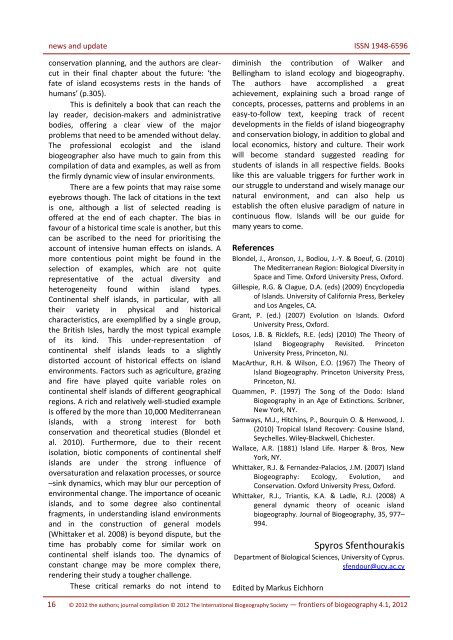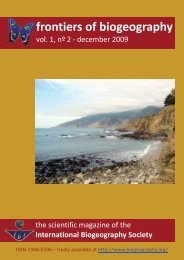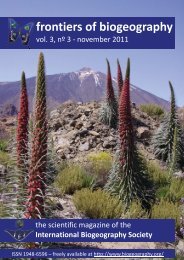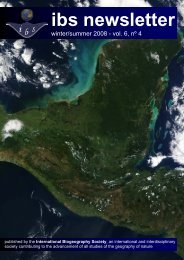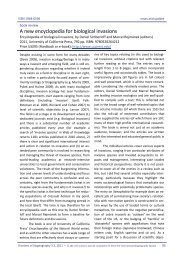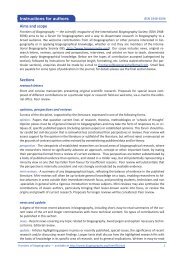1 - The International Biogeography Society
1 - The International Biogeography Society
1 - The International Biogeography Society
- No tags were found...
Create successful ePaper yourself
Turn your PDF publications into a flip-book with our unique Google optimized e-Paper software.
news and update ISSN 1948-6596conservation planning, and the authors are clearcutin their final chapter about the future: ‘thefate of island ecosystems rests in the hands ofhumans’ (p.305).This is definitely a book that can reach thelay reader, decision-makers and administrativebodies, offering a clear view of the majorproblems that need to be amended without delay.<strong>The</strong> professional ecologist and the islandbiogeographer also have much to gain from thiscompilation of data and examples, as well as fromthe firmly dynamic view of insular environments.<strong>The</strong>re are a few points that may raise someeyebrows though. <strong>The</strong> lack of citations in the textis one, although a list of selected reading isoffered at the end of each chapter. <strong>The</strong> bias infavour of a historical time scale is another, but thiscan be ascribed to the need for prioritising theaccount of intensive human effects on islands. Amore contentious point might be found in theselection of examples, which are not quiterepresentative of the actual diversity andheterogeneity found within island types.Continental shelf islands, in particular, with alltheir variety in physical and historicalcharacteristics, are exemplified by a single group,the British Isles, hardly the most typical exampleof its kind. This under-representation ofcontinental shelf islands leads to a slightlydistorted account of historical effects on islandenvironments. Factors such as agriculture, grazingand fire have played quite variable roles oncontinental shelf islands of different geographicalregions. A rich and relatively well-studied exampleis offered by the more than 10,000 Mediterraneanislands, with a strong interest for bothconservation and theoretical studies (Blondel etal. 2010). Furthermore, due to their recentisolation, biotic components of continental shelfislands are under the strong influence ofoversaturation and relaxation processes, or source–sink dynamics, which may blur our perception ofenvironmental change. <strong>The</strong> importance of oceanicislands, and to some degree also continentalfragments, in understanding island environmentsand in the construction of general models(Whittaker et al. 2008) is beyond dispute, but thetime has probably come for similar work oncontinental shelf islands too. <strong>The</strong> dynamics ofconstant change may be more complex there,rendering their study a tougher challenge.<strong>The</strong>se critical remarks do not intend todiminish the contribution of Walker andBellingham to island ecology and biogeography.<strong>The</strong> authors have accomplished a greatachievement, explaining such a broad range ofconcepts, processes, patterns and problems in aneasy-to-follow text, keeping track of recentdevelopments in the fields of island biogeographyand conservation biology, in addition to global andlocal economics, history and culture. <strong>The</strong>ir workwill become standard suggested reading forstudents of islands in all respective fields. Bookslike this are valuable triggers for further work inour struggle to understand and wisely manage ournatural environment, and can also help usestablish the often elusive paradigm of nature incontinuous flow. Islands will be our guide formany years to come.ReferencesBlondel, J., Aronson, J., Bodiou, J.-Y. & Boeuf, G. (2010)<strong>The</strong> Mediterranean Region: Biological Diversity inSpace and Time. Oxford University Press, Oxford.Gillespie, R.G. & Clague, D.A. (eds) (2009) Encyclopediaof Islands. University of California Press, Berkeleyand Los Angeles, CA.Grant, P. (ed.) (2007) Evolution on Islands. OxfordUniversity Press, Oxford.Losos, J.B. & Ricklefs, R.E. (eds) (2010) <strong>The</strong> <strong>The</strong>ory ofIsland <strong>Biogeography</strong> Revisited. PrincetonUniversity Press, Princeton, NJ.MacArthur, R.H. & Wilson, E.O. (1967) <strong>The</strong> <strong>The</strong>ory ofIsland <strong>Biogeography</strong>. Princeton University Press,Princeton, NJ.Quammen, P. (1997) <strong>The</strong> Song of the Dodo: Island<strong>Biogeography</strong> in an Age of Extinctions. Scribner,New York, NY.Samways, M.J., Hitchins, P., Bourquin O. & Henwood, J.(2010) Tropical Island Recovery: Cousine Island,Seychelles. Wiley-Blackwell, Chichester.Wallace, A.R. (1881) Island Life. Harper & Bros, NewYork, NY.Whittaker, R.J. & Fernandez-Palacios, J.M. (2007) Island<strong>Biogeography</strong>: Ecology, Evolution, andConservation. Oxford University Press, Oxford.Whittaker, R.J., Triantis, K.A. & Ladle, R.J. (2008) Ageneral dynamic theory of oceanic islandbiogeography. Journal of <strong>Biogeography</strong>, 35, 977–994.Spyros SfenthourakisDepartment of Biological Sciences, University of Cyprus.sfendour@ucy.ac.cyEdited by Markus Eichhorn16 © 2012 the authors; journal compilation © 2012 <strong>The</strong> <strong>International</strong> <strong>Biogeography</strong> <strong>Society</strong> — frontiers of biogeography 4.1, 2012


